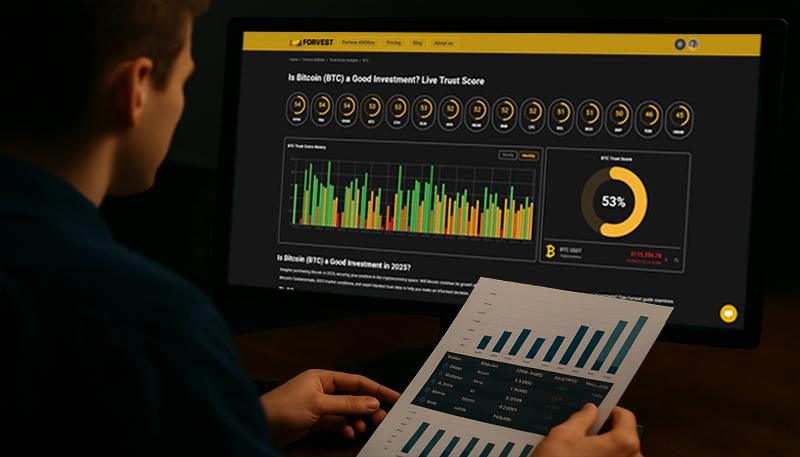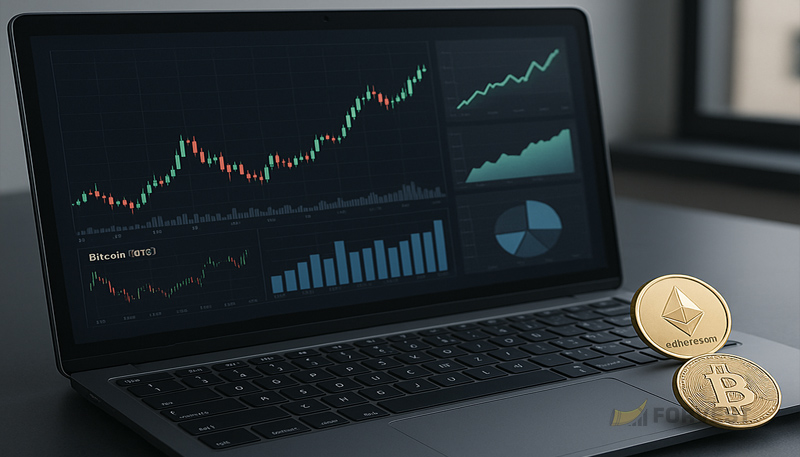How to Invest in Cryptocurrency: Step-by-Step Beginner’s Guide (2025 Edition)
A complete beginner’s roadmap to crypto investing — from choosing exchanges and wallets to managing risks and building a long-term portfolio.

Learn how to invest in cryptocurrency the smart way in 2025 — from setting up secure wallets and choosing regulated exchanges to managing risk and building a diversified crypto portfolio. Forvest combines data-driven analysis and Trust Scores to help investors make safer decisions.
TL;DR Key Takeaways:
- Learn crypto fundamentals: Understand blockchain and cryptocurrency basics, and heed warnings that crypto investments carry “serious risks”.
- Set up securely: Use hardware or software wallets to control your private keys, and trade only on regulated exchanges with KYC. Apply strong passwords and 2FA everywhere.
- Build your portfolio: Focus on the largest assets (Bitcoin ~57% market cap, Ethereum ~13%), consider stablecoins for safety, and diversify into select altcoins. Use long-term strategies like staking and ETFs for yield (see Step 5).
Step 1: Understanding Crypto Basics

What Is Cryptocurrency?
A cryptocurrency is a digital medium of exchange secured by cryptography. There is no central issuer – instead crypto runs on blockchain, a decentralized ledger. For example, PwC notes that blockchain “enables the existence of cryptocurrency,” which is a “digital medium of exchange”. Common examples include Bitcoin (launched 2009), Ethereum (2015), and thousands more. (CoinGecko tracks ~18,900 crypto assets as of late 2025.)
Blockchain 101
A blockchain is a distributed database where transactions are grouped into blocks. Each block links to the previous one via cryptographic hashes, forming an immutable chain. No single party can alter past transactions without consensus. This technology underpins all cryptocurrencies, allowing peer-to-peer transfers of value without banks.
Why People Invest
Cryptos often promise high returns and innovation. Bitcoin is sometimes called “digital gold” (finite supply) and used as an inflation hedge. Ethereum powers decentralized finance (DeFi) apps and smart contracts. However, regulators warn of dangers: SEC Chair Gary Gensler cautions that crypto assets can be marketed as opportunities but carry “serious risks”. Always be aware of extreme volatility and fraud.
What this means for you: Crypto is a new asset class – start by learning the key definitions and technology. Thousands of tokens exist, but only a few (like BTC/ETH) have proven networks. A strong foundation in blockchain basics will guide you in setting up wallets and choosing coins.
| Year | Bitcoin Year-End Price (USD) | Ethereum Year-End Price (USD) |
|---|---|---|
| 2017 | ~$14,156.40 | ~$756.73 |
| 2018 | ~$3,742.70 | ~$133.37 |
| 2019 | ~$7,193.60 | ~$130.20 |
| 2020 | ~$29,001.72 | ~$737.11 |
| 2021 | ~$46,306.45 | ~$3,679.00 |
| 2022 | ~$16,547.50 | ~$1,196.00 |
| 2023 | ~$42,265.19 | ~$2,281.00 |
| 2024 | ~$93,429.20 | ~$3,340.00 |
Step 2: Setting Up Your Investment Tools
Investors can buy cryptocurrencies through exchanges, wallets, and hardware storage devices. Each method has its pros and cons, which we compare below.
1. Centralized Crypto Exchanges (CEX)
Centralized exchanges are the most common and user-friendly platforms for buying and trading cryptocurrencies. These platforms act as intermediaries, holding user funds and facilitating trades.
✅ Advantages:
Easy to use for beginners.
High liquidity (fast transactions and competitive pricing).
Supports fiat-to-crypto purchases (credit/debit cards, bank transfers).
Advanced trading tools available.
❌ Disadvantages:
Requires KYC (Know Your Customer) verification.
Higher security risks (exchanges are prime targets for hacks).
Centralized control (exchange holds your assets, not you).
🔹 Best for: Beginners & traders who want an easy buying experience.
Realated : How to Buy Cryptocurrency on Centralized Exchanges: Beginner’s Guide (2025)
Popular Centralized Exchanges:
| Exchange | Features | Security | Fees | Fiat Support | Best For |
|---|---|---|---|---|---|
| Binance | High liquidity, advanced trading tools, large crypto selection | Medium (frequent attacks, but strong security measures) | Low | Yes | Active traders & high-volume trading |
| Coinbase | Beginner-friendly, insured funds, strong regulatory compliance | High (regulated in the US, FDIC insurance for USD) | High | Yes | New investors & long-term holders |
| Kraken | Advanced security, fiat support, futures & margin trading | High (strong security measures) | Medium | Yes | Experienced traders & institutional investors |
| Bybit | Leverage trading, derivatives & options trading | Medium | Low | No | Traders focused on derivatives |
| KuCoin | Wide variety of altcoins, staking & lending options | Medium (some past security breaches) | Low | Yes | Investors interested in small-cap cryptos |
2. Decentralized Exchanges (DEX)
Decentralized exchanges allow peer-to-peer (P2P) trading without intermediaries. They offer better privacy but have some drawbacks in terms of liquidity and ease of use.
✅ Advantages:
No KYC required (full privacy & control over funds).
Direct wallet-to-wallet transactions (no intermediaries).
Lower risk of centralized exchange hacks.
❌ Disadvantages:
No fiat payment options (you need crypto to trade crypto).
Higher fees due to network congestion.
Limited liquidity compared to centralized exchanges.
🔹 Best for: Experienced traders who value privacy & decentralization.
Popular Decentralized Exchanges:
| Exchange | Features | Security | Fees | Fiat Support | Best For |
| Uniswap | Largest Ethereum-based DEX, easy token swaps | High (smart contract-based) | High (network fees) | No | DeFi investors & Ethereum-based tokens |
| PancakeSwap | Binance Smart Chain DEX, low fees, staking | High | Low | No | Binance Smart Chain (BSC) users |
| dYdX | Decentralized derivatives trading | High | Low | No | Margin & futures traders |
| SushiSwap | Multi-chain support, yield farming, staking | High | Medium | No | Yield farmers & passive income seekers |
| Curve Finance | Focused on stablecoin trading | High | Low | No | Stablecoin traders |
Realated : What Are Decentralized Exchanges (DEX) and How Do They Work?
3. Buying Crypto in Wallet Apps
Some crypto wallets allow users to purchase cryptocurrencies directly within the app. This method is more secure than centralized exchanges but often comes with higher fees.
✅ Advantages:
Allows direct purchases without using an exchange.
Funds are stored in your wallet, not a third party.
Some wallets offer staking & DeFi features.
❌ Disadvantages:
Limited crypto selection compared to major exchanges.
May have higher fees than exchanges.
If you lose your private key, you lose access to funds forever.
🔹 Best for: Investors who prioritize security & direct ownership.
Popular Wallets That Allow Crypto Purchases:
| Wallet | Features | Security | Fees | Fiat Support | Best For |
| MetaMask | Ethereum & multi-chain support, dApp integration | High (user-controlled private keys) | High (network fees) | Yes | DeFi & Web3 users |
| Trust Wallet | Supports multiple blockchains, built-in staking | High | Medium | Yes | Mobile users & DeFi traders |
| Ledger Live (Hardware Wallet) | Buy & manage crypto directly on Ledger hardware | Very High (cold storage) | Medium | Yes | Long-term investors |
| Exodus | Multi-chain support, integrated swaps | High | Medium | Yes | Users looking for a user-friendly, secure wallet |
4. Buying & Storing Crypto on Hardware Wallets (Ledger, Trezor, etc.)
For those looking for maximum security, hardware wallets provide offline cold storage for crypto assets, keeping them safe from hacks.
✅ Advantages:
Maximum security (cold storage, offline storage, immune to hacks).
Full control over your private keys.
Ideal for long-term storage.
❌ Disadvantages:
Cannot trade quickly (not ideal for active traders).
Costs money (~$50-$200 for hardware wallets).
Losing the device without a backup means losing your crypto forever.
🔹 Best for: Long-term investors who prioritize security over convenience.
Popular Hardware Wallets:
| Wallet | Features | Security | Best For |
| Ledger Nano X | Bluetooth connectivity, multi-crypto support | Very High (cold storage) | Long-term investors & large holders |
| Trezor Model T | Touchscreen interface, open-source firmware | Very High | Investors prioritizing open-source security |
| SafePal S1 | Air-gapped signing for enhanced security | High | Users seeking an affordable hardware wallet |
Final Thoughts: Choosing the Right Crypto Investment Method
The best method for investing in cryptocurrency depends on your needs:
For Beginners: Start with a user-friendly centralized exchange (Coinbase, Binance).
For Privacy-Focused Investors: Use a DEX (Uniswap, PancakeSwap) to maintain anonymity.
For Security-Conscious Holders: Use a hardware wallet like Ledger or Trezor.
For Passive Income Seekers: Choose platforms with staking & yield farming options.
Comparison Table: Crypto Investment Methods
| Method | Ease of Use | Security | Liquidity | Best for |
|---|---|---|---|---|
| Centralized Exchange (CEX) | ⭐⭐⭐⭐ | ⭐⭐ | ⭐⭐⭐⭐⭐ | Beginners & active traders |
| Decentralized Exchange (DEX) | ⭐⭐⭐ | ⭐⭐⭐ | ⭐⭐⭐ | Privacy-focused investors |
| Wallet Apps | ⭐⭐⭐ | ⭐⭐⭐⭐ | ⭐⭐ | Security-conscious users |
| Hardware Wallets (Cold Storage) | ⭐ | ⭐⭐⭐⭐⭐ | ⭐ | Long-term holders & high-net-worth investors |

Step 3: Choosing Which Cryptocurrencies to Invest In
Not all cryptocurrencies are good investments. Here’s how to evaluate a crypto project before investing:
✅ Market Cap & Liquidity: Higher market cap = more stability. ✅ Project Use Case: Does it solve a real-world problem? ✅ Development Team: Are the founders reputable? ✅ Community Support: Strong community = higher adoption potential. ✅ Security & Regulation: Avoid projects with frequent hacks or unclear legal standing.
💡 Tip: Use Fortuna AI’s Trust Score Analysis to find low-risk and high-trust cryptocurrencies.
Step 4: Risk Management & Safety
Cryptocurrency investing carries significant risks. Plan for them with these principles:
Diversification & Volatility
Spread your holdings across multiple coins to reduce risk. U.S. regulators advise diversifying to mitigate losses. A typical strategy is to allocate the majority to Bitcoin/Ethereum and the rest to other tokens. Be prepared for large price swings – historically Bitcoin has been about 3–4× more volatile than broad stock indices[2].
Regulatory & Compliance
Use only regulated services. In many countries, crypto assets are treated as securities: for example, the SEC has charged unregistered token offerings in 2025. In the EU, the MiCA framework (effective 2024) imposes strict rules on crypto issuers and exchanges. ESMA warns investors about a “halo effect” when platforms mix regulated and unregulated crypto products. Always verify that exchanges are licensed and follow KYC/AML rules, and remember that crypto gains are generally taxable.
Protect it from Threats
- Enable 2FA (Two-Factor Authentication) – Adds extra security to your exchange/wallet.
- Use Hardware Wallets – Keep large holdings in cold storage.
- Avoid Phishing Scams – Never share your private key with anyone.
- Backup Your Wallet Seed Phrase – Store it offline in a safe place.

Step 5: Building a Long-Term Strategy
Staking & Yield: Many cryptocurrencies let you earn passive returns by staking or lending. Proof-of-Stake networks (e.g. Ethereum, Solana, Cardano) often pay a few percent annual yield for staking coins. Decentralized finance (DeFi) protocols and some exchanges also offer interest on lent crypto or stablecoins. Research each platform’s rules and risks (lock-up periods, smart-contract security) before staking. Higher yields usually mean higher risk.
Crypto Funds & ETFs: Regulated funds can simplify investing. In the U.S., multiple spot Bitcoin ETFs launched in January 2024, allowing you to buy Bitcoin through a brokerage account with SEC oversight. Similar Ethereum ETFs have also been approved. These funds trade like stocks and require issuers to disclose holdings, adding a layer of investor protection. In other regions (EU, Canada, Australia), crypto investment funds and ETFs have similar regulatory backing. Using ETFs means you get crypto exposure without holding the coins yourself (the fund custodies them).
Portfolio Rebalancing: Decide on target allocations (e.g. 50% BTC, 30% ETH, 20% others). Periodically rebalance to maintain these targets: for example, if Bitcoin’s weight grows to 60%, sell some BTC to buy others. Rebalancing enforces “sell high, buy low.” Also consider dollar-cost averaging: invest fixed amounts at regular intervals to smooth out volatility. For structured tracking and rebalancing, use tools like Forvest’s Portfolio Management platform.
What this means for you: Adopt a long-term mindset. Stake or hold core coins for the long run, and consider regulated products (like ETFs) for convenience. Stick to your plan: invest regularly, rebalance when necessary, and don’t be swayed by every market swing. Your patience and discipline will pay off over time.
Risks to Watch
Security Breaches & Scams
Even major exchanges and wallets can be hacked. Always enable all security features (2FA, hardware keys) and never share your keys. Check URLs carefully and avoid sending coins to unknown addresses. Law enforcement (e.g. FBI Operation Level Up) reports that many crypto fraud victims never realized they were being scammed. Stay on guard for phishing emails and impersonators.
Market Volatility
Crypto prices can swing dramatically. For example, Bitcoin has seen +100% years and -80% crashes. Daily moves of 10–20% are common. Do not invest money you cannot afford to lose. Maintain cash or other assets as an emergency fund. If prices drop, avoid panic-selling – these swings are part of crypto. A steady, diversified approach is usually better than trying to time the market.
Regulatory Changes
Laws and policies around crypto are evolving. The EU’s Markets in Crypto-Assets (MiCA) rules took effect in 2024, affecting crypto companies and stablecoin issuers. In the U.S., regulators continue to introduce new rules and enforcement (e.g. SEC actions in 2024–25). Tax codes also apply to crypto gains in most countries. Keep informed about legal developments in your region and use only compliant platforms to avoid unpleasant surprises.
What this means for you: Crypto investing requires vigilance. Continuously secure your assets, stay calm during price swings, and follow legal requirements. Use reputable services (like Forvest’s vetted tools and regulated exchanges) to lower your risk. Always have an exit strategy: know how and when you would convert crypto back to fiat if needed.
Conclusion & Next Steps
This analysis reflects data verified as of September 30, 2025. For live updates and breaking crypto news, check Forvest’s News Review. You now have a clear roadmap: learn crypto basics, secure your setup, choose assets wisely, manage risk, and invest with a long-term plan. As a next step, consider setting up a small practice portfolio or using a simulation tool to apply these steps. Monitor your holdings and rebalance as needed. Tools like Forvest’s Portfolio Management can help you track performance over time.
Rating of this post
Rate
If you enjoyed this article, please rate it.
FAQ: Investing in Cryptocurrency
Cryptocurrency is digital money powered by cryptography. It uses a blockchain, which is a public, decentralized ledger that records all transactions in blocks. Once recorded, data in a block cannot be changed without consensus, making the system secure. Blockchain enables transfers without intermediaries, meaning no central bank controls the currency
A hardware wallet (Ledger, Trezor) offers the highest level of security. For convenience, secure software wallets like MetaMask or Trust Wallet are good alternatives.
Yes. You can buy directly in some wallets or use peer-to-peer (P2P) platforms. However, these methods may have higher fees or lower liquidity.
There are no 100% safe investments, but large-cap cryptos like Bitcoin (BTC) & Ethereum (ETH) are considered more stable. Use Fortuna AI’s Trust Score for risk evaluation.
1️⃣ Research different cryptocurrencies. 2️⃣ Choose a secure buying method (exchange, wallet, or cold storage). 3️⃣ Start with a small amount. 4️⃣ Store your crypto securely. 5️⃣ Stay informed & monitor market trends.
Rating of this post
Rate
If you enjoyed this article, please rate it.



